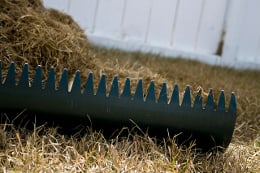How to Dethatch a Bermudagrass Lawn
 A well-maintained Bermudagrass lawn will grow rapidly and thickly, something that you will welcome as a lawn owner. A potential downside to this constant growth, however, is the accumulation of a thatch layer between the grass and the soil. Of course, if you are planting a new lawn from Bermudagrass seed, this won’t be necessary for a while!
A well-maintained Bermudagrass lawn will grow rapidly and thickly, something that you will welcome as a lawn owner. A potential downside to this constant growth, however, is the accumulation of a thatch layer between the grass and the soil. Of course, if you are planting a new lawn from Bermudagrass seed, this won’t be necessary for a while!
Thatch tends to go hand-in-hand with highly maintained lawns, especially ones with creeping grass growth, such as bermudagrass. Thatch is the layer of dead plant material that has not yet been decomposed by microorganisms in the soil. This material usually includes roots, rhizomes, crowns, and stems. All of these materials tend to have ligin, which is resistant to decay (as a note, clippings contain no ligin and do not contribute to thatch in any way).
A small layer of thatch is actually a good thing. A thatch layer that is no more than ½” thick can prevent weed germination and water evaporation, provide insulation against extreme cold, and protect the lawn from injuries caused by high impact traffic. But when that layer exceeds more than ½”, problems begin to arise. Too much thatch can prevent water, oxygen, and nutrients from penetrating the soil. Thatch can reduce the effectiveness of herbicides, fertilizers, and pesticides. The thatch layer can become home to pests and disease pathogens. The lawn is more likely to be scalped because the lawn mower tends to sink into the spongy thatch layer. And eventually the roots will be growing in thatch rather than soil, making the lawn more susceptible to heat, cold, and drought.
How can you tell if your lawn is growing on a thatch layer? If the lawn is doing poorly despite regular maintenance, and if the surface feels springy, puffy or spongy, there’s a good chance that an excessive thatch layer is the culprit. To know for sure, cut a lawn sample that is at least 3” deep and measure the thickness of the thatch layer, between the soil and the grass.
To remove thatch from your bermudagrass lawn, you will need either a thatching rake or a vertical mower. A thatching rake works well from small lawns, while a vertical mower works well for bigger lawns. Adjust the mowing blades depending on the thickness of the thatch layer. It is better to underestimate rather than overestimate the amount of thatch you need to remove—too much de-thatching can permanently damage the lawn.

Remember that you should always de-thatch during the bermudgrass lawn’s growing season. This will be during the late spring and early summer, when there are several weeks left for the lawn to repair itself before its winter dormancy.
Depending on how much your lawn grows, you may have to de-thatch the lawn once or twice a year. There are some things you can do to prevent thatch from growing, however. Don’t over fertilize or over water your lawn. Mow and aerate the lawn regularly. Try adding occasional topdressings of soil to the lawn, no more than 1/8”. Encourage a strong microbial population by maintaining a neutral soil pH, adding organic soil amendments, and abstaining from the overuse of pesticides. All of these factors will help slow the amount of accumulated thatch, and result in a healthier, more responsive lawn.


